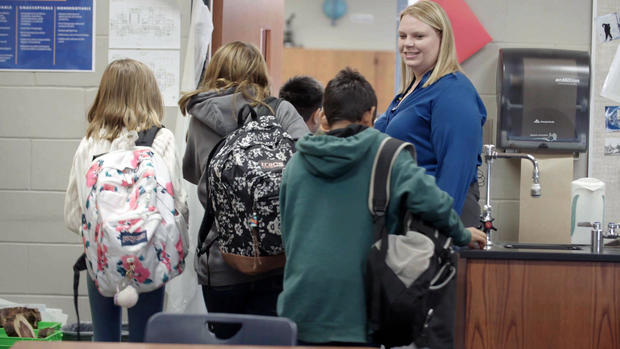REVERB is a new documentary series from CBSN Originals. Watch the latest episode, “The War on Science,” in the video player above.
Melissa Lau, a middle-school science teacher in Piedmont, Oklahoma, with over 19 years of experience, stood by the doorway of her classroom as the last few of her first-period sixth grade students filed in and took their seats.
“Hey guys, you need your papers from yesterday, and a pencil,” said Lau, launching into the day’s lesson. “So, how can I identify misleading information? I know you guys know conspiracy theories. You guys watch enough YouTube to know what that stuff is.” Lau told CBSN Originals that the rise of pseudoscience on the video-sharing platform has made her job teaching science more difficult — and more important.
Since its launch in 2005, YouTube has amassed an audience of over 2 billion monthly active users. Part of the secret of its success is the personalization algorithm that suggests videos based on viewing habits, a process that can create a feedback loop of misinformation. With just a click or two, students can be drawn into debunked and anti-scientific diatribes about climate change, evolution, and even whether the Earth is flat.
Based on recent surveys, children are increasingly likely to rely on YouTube for information. A 2019 report from Common Sense Media found that 56% of kids ages 8 to 12, and 69% of teens ages 13 to 18, watch videos online every day. According to a Pew Research survey of YouTube users, half said they use the platform for education purposes. But many of the videos they may encounter on science topics are not based on established scientific data at all, and instead promote pseudoscience, false claims and conspiracy theories.
“If you’re already predisposed to be interested in conspiracy theories and you’re watching videos on conspiracies, the ‘flat Earth’ videos are going to be suggested to you. When you search for shapes of the Earth, it’s the ‘flat Earth’ data that’s going to be presented to you,” said Asheley Landrum, an assistant professor at Texas Tech University who specializes in science communication.
“You end up in an echo chamber where you’re being exposed more to this evidence than the information that would correct the ‘flat Earth’ views you’re talking about.”
YouTube, which is owned by Google, has community guidelines that ban “harmful” content, but there’s no specific policy against spreading false or misleading ideas about science. However, YouTube says it has made strides recently in fighting misinformation on the platform. In a December 2019 blog post, the company said:
“Over the past couple of years, we’ve been working to raise authoritative voices on YouTube and reduce the spread of borderline content and harmful misinformation. And we are already seeing great progress. Authoritative news is thriving on our site. And since January 2019, we’ve launched over 30 different changes to reduce recommendations of borderline content and harmful misinformation.”
It said that includes reducing the site’s recommendations of “videos that could misinform people in harmful ways” — for example, those “promoting a phony miracle cure [or] claiming the earth is flat.”
A new study from researchers at the University of California-Berkeley confirms that YouTube has significantly cut down on recommending “conspiratorial” videos. However, the study also found that once a conspiratorial video is clicked, there is a high (though decreasing) likelihood that YouTube will recommend another similar video. So even though it has become harder to fall into a feedback loop of anti-scientific YouTube videos, the problem still exists.
“It’s a big issue that goes way beyond science education,” said Ann Reid, executive director of the nonprofit science advocacy group the National Center for Science Education. “But science education is perhaps one of the best tools we have to help students resist that kind of misinformation.”
To combat misinformation online and help teachers who don’t have easy access to professional development for teaching climate change and evolution, the National Center for Science Education launched a program designed to promote effective science communication skills.
Melissa Lau was recently trained in the program and uses what she learned when teaching her sixth grade science students. She believes learning how to distinguish fact from fiction is absolutely essential in today’s world.
“[The students] don’t just take it for climate change and climate science acceptance and denial, they have this skill to be able to find when someone is misleading them with a political ad, or if someone is misleading them with any kind of pseudoscience, anti-vaxx or ‘flat Earth’ or anything like that that’s going around right now,” Lau said. “It’s a survival skill in this day and age.”



